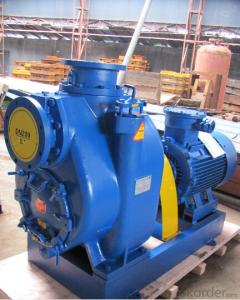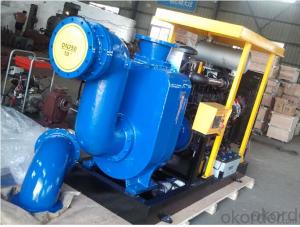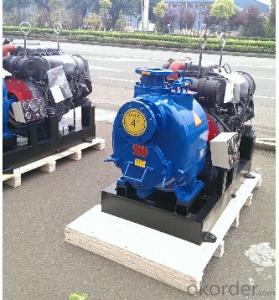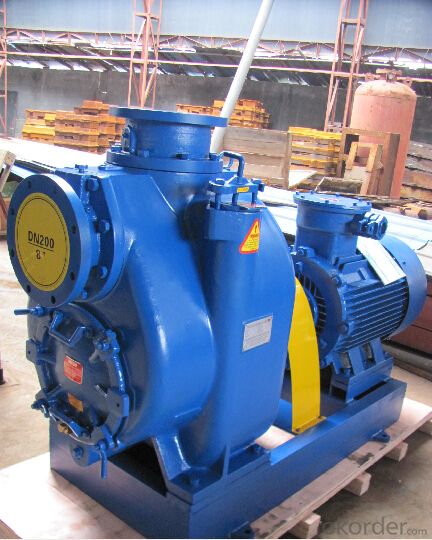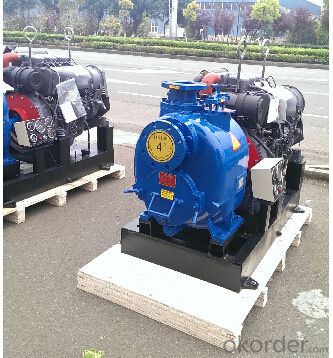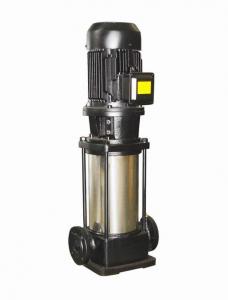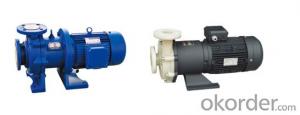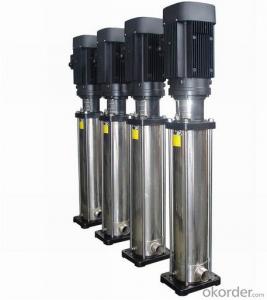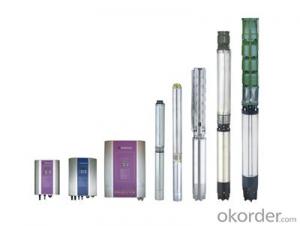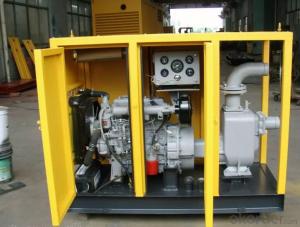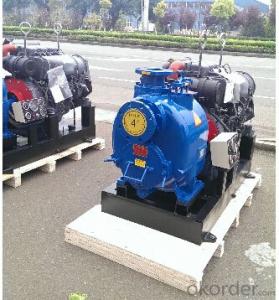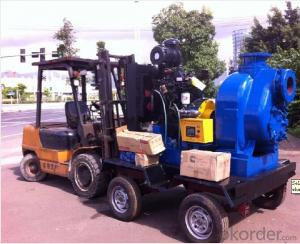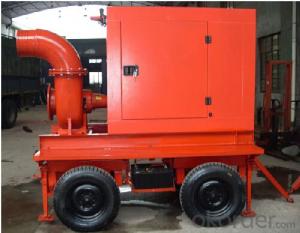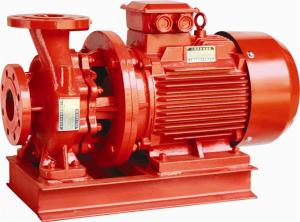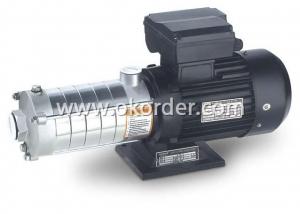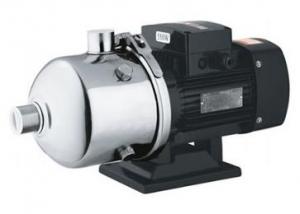Self Priming Diesel Engine Pump for Irrigation
- Loading Port:
- Shanghai
- Payment Terms:
- TT OR LC
- Min Order Qty:
- 1 set
- Supply Capability:
- 10000 set/month
OKorder Service Pledge
OKorder Financial Service
You Might Also Like
Self Priming Diesel Engine Pump for Irrigation
1.Structure of Self Priming Diesel Engine Pump for Irrigation Description
The pumps are designed for economical & trouble-free operation in handling solids-laden liquids and slurries, it handle up to 76.2mm spherical solids. Pumps feature a large volute design which allows them to re-prime automatically in a completely open system without the need of suction or discharge check valves. And this is workable with the pump only partially filled with liquid and completely dry suction line.Standard Self-Priming pump units are available for Solids Handling or Clear Liquid service. Typical mounting configurations areEngine Driven for Skid or Trailer Mounted packages and Frame Mounted Electric Driven. Pumps also are available in a variety of different metallurgies.
2.Main Features of Self Priming Diesel Engine Pump for Irrigation
• Big pump body pass 76.2mmsolid ,high suction head 7.6 m
•Replaceable Wear Plate
•Heavy Duty Suction Flapper
•Removable Inspection Cover allows Clean-out, Impeller, Seal and Flapper without disturbing Piping
•Semi-Opened Trash Handling Impeller
•Cartridge Type Mechanical Seal for Ease of Maintenance
3.Self Priming Diesel Engine Pump for Irrigation images

4.Self Priming Diesel Engine Pump for IrrigationSpecification
Material |
Cast Iron, ADI, CD4MCU, 316 SS, Alloy 20, C276. |
Diesel Driving |
Water cooled or air cooled |
Method of Connection | Self-priming pumps are available as basic units or may be flex-coupled, V-belt driven or engine mounted. |
Inlet/Outlet |
2''(50mm), 3''(75mm), 4''(100mm), 6''(150mm), 8''(200mm), 10''(250mm), 12''(300mm) |
Impeller Diameter |
158.74mm-457.2mm |
Rotary Speed |
550RPM-2150 RPM |
Flow Rates |
8m3/h-1275m3/h |
Head |
6m-63m |
Horsepower |
1HP-125HP |
Solid Passing |
20.63mm-76.2mm |
5.FAQ
①What is the lead time for samples?
7-10days
②How long can we receive the product after purchase?
In the purchase of product within three working days, We will arrange the factory delivery as soon as possible. It related to the state and detailed requirement of customers.
- Q: I need information about basic water pumps. I'll have to build a mechanical one for school. Do you have any ideas, information, designs, links? Thanks!
- There are a number of different types of pumps (and some overlap between types, too). A suction pump basically sucks water up. This might be a piston pump, or a venturi pump (or some other types). This type of pump raises water up by lowering the air pressure above the water, and letting atmospheric pressure push the water up the tube. Suction pumps can't pull water up more than about 32 feet (because that's how high atmospheric pressure can lift a column of water) but they have the advantage that the pump can be located at the top of where you want the water (rather than down where tie water is). A Lift pump basically uses mechanical force to raise water upwards. This could be a chain of buckets, or an Archimedes screw, or a bubble-lift pump. All these pumps need to have at least part of the pump down at the water level (with the exception of the bubble lift, which is kind of a unique design). The most common water pumps are centrifugal pumps. These use a set of spinning vanes to pressurize the water. Water comes in at the center, and hit spinning vanes; these shove the water outward through centrifugal force, and the outlet pipe is at the outside edge of the circle. One other interesting type of pump is the hammer pump. It's sometimes used in remote farming areas, because you can use the energy of a running stream to pump water high up a cliff. In a hammer pump, you let water flow through a relatively long tube. The tube has a vertical pipe near it's end. You let the water run through, and then suddenly close off the end of the pipe. The momentum of the water (combined with the fact that water isn't very compressible) can force a shot of water very far up the vertical tube. Hope this gives you enough to search for on the web!
- Q: I have a well water pump and the motor seems to just run but won't transfer water through the line, checked for leakage, etc but no signs. Even tried priming it but it does nothing. Any idea of what could be wrong or how to repair this problem?
- If the captive air tank has failed you should still get some water flow. if you are not getting any flow and the pump is spinning then the pump may need to be replaced. There is also a pressure switch that may have failed but if that were the case you would have got flow unless the pump burned up. so, bottom line is this. 1) turn power off. let a tiny bit of air out of the Schroeder valve on the captive air tank. if water comes out, the tank is bad. make sure to fill the tank up to about 40psi. 2)turn power off. remove the cover of the pressure switch and clean with compressed air. move the switch back and forth. sand the contacts with emory cloth. 3) if the tank was good turn the power back on and make sure all the valves are open (even the ones you havent touched) if you are still not getting water you should probably call a plumber. most likely at this point you have a bad switch or tank and it has caused your pump to burn up. good luck
- Q: My toyota 99 camry stalled and would not start. engine turned over and all lights worked. had the oil changed 3 weeks ago and they told me their was a noise and it might be the water pump. my questions are does this sound like the water pump? Do they usually change the timing belt and is this necessary? is this something that we can do at home? thank-you for any info out their!
- If your water pump is the problem, the stalling and not starting would've been caused by your engine overheating. Hopefully that's not the case. Also, waterpumps tend to make a noise when they go bad, but the most common symptom is the loss of coolant in your radiator. The waterpump will began to drip when it goes bad. If you are getting the waterpump done, I would bite the bullet and spend the loot on a full timing belt replacement. My reasons are this: In order to get to the waterpump, all of the belts (including the timing belt) will need to be removed. This is one case where a mechanics advice on additional work works in your favor. If you replace the timing belt while replacing the waterpump, you will be saving hundreds of dollars in labor in the long run. The timing belt change isn't necessary, and you don't have to worry about damaging your engine if it breaks. your Camry has a noninterference engine so you'll just need to replace the belt when it breaks and you're good to go. However, replacing it while you have the waterpump done will save you money as I mentioned before.
- Q: Could this be a result of a bad water pump.
- This is absolutely normal. Water is a byproduct of the combustion of gasoline.
- Q: I just bought a house and we have well water. When I went out to change the filter on the pump I noticed a valve leaking...I went to check on it and noticed it had two settings if you will. one says System and the other says by pass if I move the lever to system the leak stops, if I move it back to bypass the leak continues...question is which one should I have it set on and what is the purpose?
- Okay, Adam, we also have a well and just put in a new one. The setting that says System means that the water is running through the filter. The setting that says by pass means that the water is NOT running through the filter. You will have water either way in your house (or you should). It is just either, it is running through the filter, or it is not. I hope I have helped. gram
- Q: I was driving when my temp gauge shot up all the way so i pulled off the next exit and my car shut off and started smoking i noticed the water pump belt was in shreds and what seemed to be anti freeze fluid and water was everywhere. I'm curious what could have broke maybe a gasket or the waterpump it's self besides just the belt?
- The bearings within the pump, or the belt tensioner pulley bearings, or even the alternator could have gone bad. Any one of the components that draw from the serpentine belt may be the origin.Once the engine cools it may be determined which component caused the failure. If the water pump turns freely then it's not the source and can be ruled out. Same with the tensioner pulley.
- Q: I had my timing belt replaced @ 80k (now have 138k) and was told by new mechanic that the water pump was not replaced then. Do I need to have pump replaced? What will happen if I don't? Thx
- Don't worry yourself over it. Just keep on driving it and sell it as you have planned.
- Q: OK i was driving and i noticed the gas pedal wouldn't really work and people were telling me to move so right away i moved to the side of the road and got my car towed home. a couple details are that there was smoke coming out of the hood, don't know what part of the engine though.there was not much water in the water pump. my dad thinks that the problem was it was leaking the water.the car turns on ac works it just shakes when it turn on the motor no condition to drive it obviously but it does take a little time to start the engine. i want to know if anyone knows what may be the problem and about how much it may cost.ohh btw this car model is a 1999 Chrysler Sebring Convertible 2 door.thank you!
- fill radiator and then start the car. Look for any leaking. Check radiator and all hoses as well as the waterpump. also look at both heads. Still if not then do the following. Watch the radiator cap. If the steam is coming out of the cap then replace it $6. If it still goes out cap then replace the thermostat. If there is no water signs then the head gasket needs replaced
- Q: 1.5 kW three-phase pump with 600 meters line, should match what big line?
- Do you want to see the line loss how much pressure drop, if you want to ensure the working voltage of certain you pump, 600m pressure drop should be two-way, namely power press 1200m, press 380V, 1.5KW working current is calculated according to 3A R=, according to the resistivity * length / cross-sectional area of =0.0175*1200/S=21/S, and the loss of pressure drop =R*I=21*3/S=63/S, S take 3, loss of pressure drop is about 20V, the comprehensive economic cost, take 3 more appropriate, if you are willing to take 5, 6 are never mind, the thicker the loss is smaller.
- Q: I have a 1978 El Camino V8 305. My power steering has been going out on me, and since then my belt has been squeaking usually when it first starts up. This morning when I got to work, smoke was bellowing from under my hood. Im trying to troubleshoot. Is it possible that my power steering pump damaged the belt enough that the water pump went out?
- The only method of positive identification is to use a mechanics stethoscope. A failing bearing is most likely causing the whine, but wear in the p/s pump can also create a whining noise which will get noticeably louder when the wheel is turned and held against the stop with the engine running.
Send your message to us
Self Priming Diesel Engine Pump for Irrigation
- Loading Port:
- Shanghai
- Payment Terms:
- TT OR LC
- Min Order Qty:
- 1 set
- Supply Capability:
- 10000 set/month
OKorder Service Pledge
OKorder Financial Service
Similar products
Hot products
Hot Searches
Related keywords
